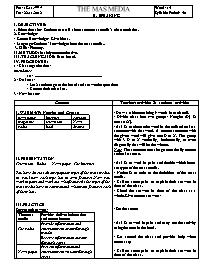Giáo án English 10 - Unit 7: The Mas Media - B.Speaking - Năm học 2012-2013

I. OBJECTIVES:
1. Education aim: Students can talk about some mass media’s characteristics.
2. Knowledge:
- General knowledge: Give ideas.
- Language: Students' knowledge about the mass media.
3. Skills: Fluency.
II. METHOD: Mainly communicative.
III. TEACHING AIDS: Extra board.
IV. PROCEDURE:
1 / Class organization :
Attendance :
10 : .
2 / Oral test :
- Let 2 students go to the board and answer the questions
- Correct their mistakes.
Bạn đang xem tài liệu "Giáo án English 10 - Unit 7: The Mas Media - B.Speaking - Năm học 2012-2013", để tải tài liệu gốc về máy bạn click vào nút DOWNLOAD ở trên
Pre : 18.11.2012 Tea: 22.11.2012 THE MAS MEDIA SPEAKING Week: 14 Syllable Period: 40 I. OBJECTIVES: 1. Education aim: Students can talk about some mass media’s characteristics. 2. Knowledge: - General knowledge: Give ideas. - Language: Students' knowledge about the mass media.. 3. Skills: Fluency. II. METHOD: Mainly communicative. III. TEACHING AIDS: Extra board. IV. PROCEDURE: 1 / Class organization : Attendance : 10 : ................................................................... 2 / Oral test : - Let 2 students go to the board and answer the questions - Correct their mistakes. 3 / New lesson : Contents Teacher/s activities & students/ activities I. WARM- UP: Noughts and Crosses newspaper Internet cartoon magazine television News radio book drama II. PRESENTATION Television Radio Newspaper The Internet You have discussed some popular types of the mass media. As you know, each type has its own features. Now, you work in pairs and work out what feature(s) the types of the mass media have in common and what main features each of them has. III. PRACTICE Suggested answers: The mass media Provide/ deliver information and entertainment The radio Provide information and entertainment orally (through mouth) Receive information aurally (through ears) Newspapers Present information and entertainment visually (through eyes) Receive information visually (through eyes) Television Present information and entertainment orally (through mouth) and visually (through eyes) Get information aurally (through ears) and visually (through eyes) - Which types of the mass media do you usually get information from? - Which one do you like most? Why? - Which type of the mass media is developing and will develop in the future? IV. FURTHER PRACTICE * Suggested answers: The mass media includes TV, The radio, Newspapers and the Internet. The feature they have in common is that they provide or deliver information and entertainment to people. The radio provides information and entertainment orally (through mouth) and receives them aurally (through ears). - Draw a table containing 9 words in each cell. - Divide class into two groups: Noughts (O) & crosses (X). - Ask Ss to choose the word in the cell and make a sentence with that word. A correct sentence with the given word will give one O or X. The group with 3 O or X vertically, horizontally, or even diagonally first will be the winner. Note: The sentences must be grammatically correct and make sense. - Ask Ss to work in pairs and decide which items are types of the mass media. - Notice Ss to refer to the definition of the mass media. - Call on some pairs to explain their answers in front of the class. - Check the answers in front of the class as a whole. Give correct answers: - Set the scene - Ask Ss to work in pairs and carry out the activity using the cues in the book. - Go around the class and provide help when necessary. - Call on some pairs to explain their answers in front of the class. - Feedback and give suggested answers: - Have Ss work in groups and talk about different types of the mass media. Note: T may use the questions in the book or the following: Gather ideas and have final thoughts on the topic. 4 . Consolidation: Summaries the main points. 5 . Homework: Assign homework
Tài liệu đính kèm:
 B.Speaking.doc
B.Speaking.doc





